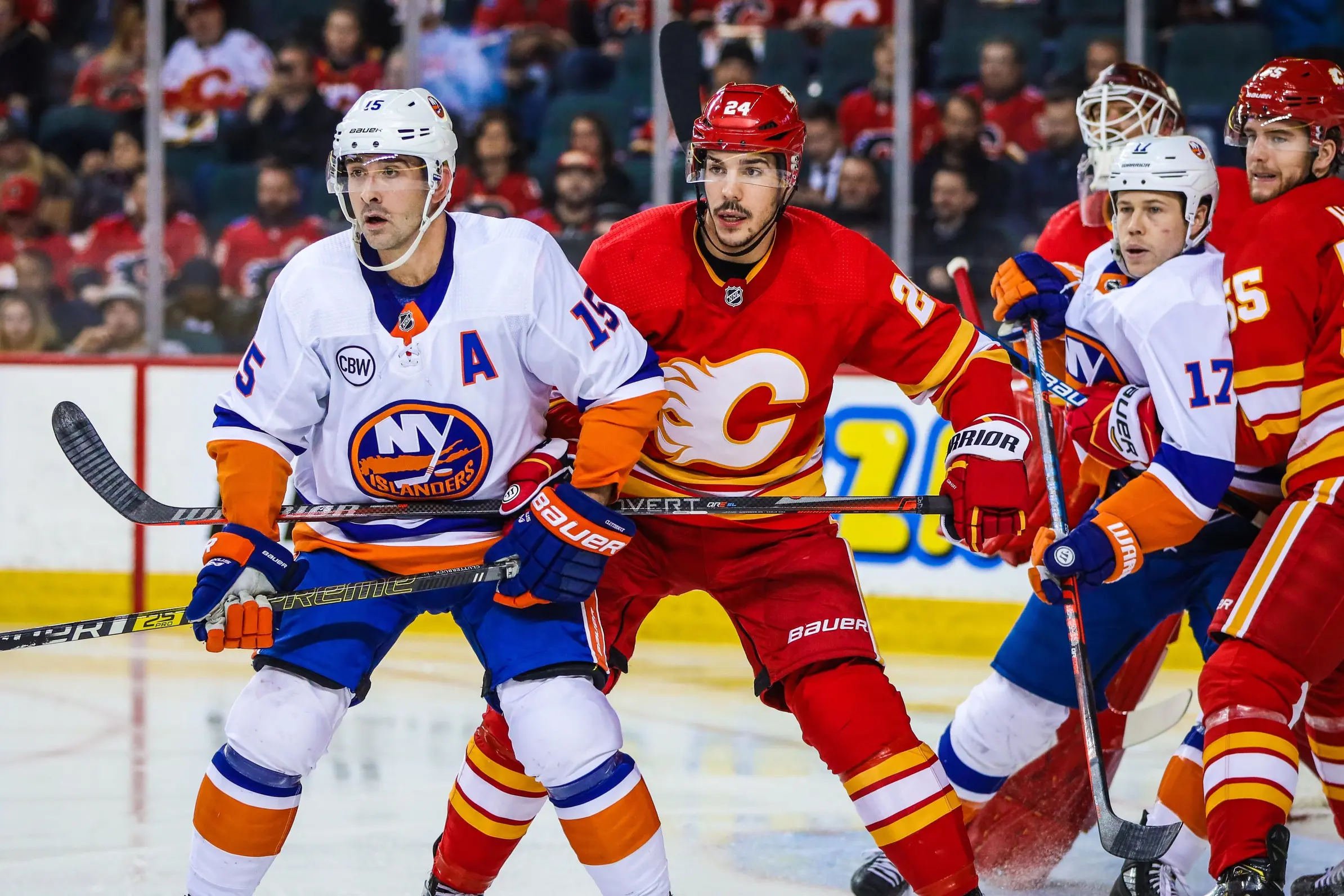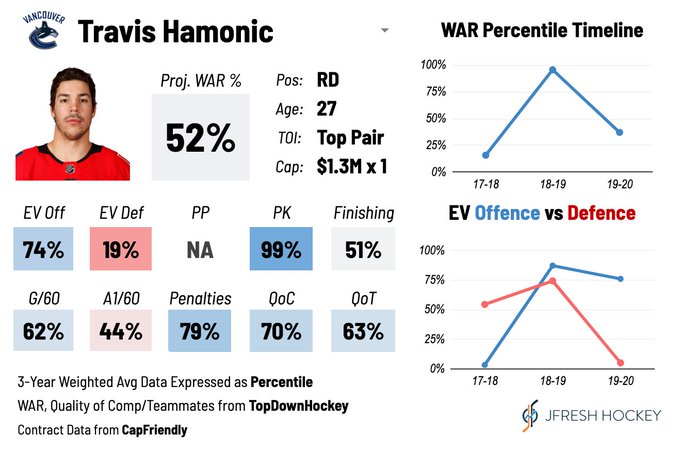Travis Hamonic, signed 1x$1.25M by VAN, is an elite penalty killer who has been one of the league's most bizarrely inconsistent defencemen in the past three seasons. #Canucks
Nation Sites
The Nation Network
FlamesNation has no direct affiliation to the Calgary Flames, Calgary Sports and Entertainment, NHL, or NHLPA
Sizzling storylines: Hamonic returns as a foe, three new Flames welcome former team

Photo credit: Sergei Belski/USA Today Sports
By Mike Gould
Jan 16, 2021, 12:00 ESTUpdated: Jan 16, 2021, 10:52 EST
By now, surely you know all about how the Calgary Flames have lost 11 season-opening games in a row.
Wait! There’s also some good news: following their last seven opening losses, the Flames have rebounded to win their second game six times.
Three of those wins have come at the expense of the Vancouver Canucks, the Flames’ opponent tonight (8 p.m. MT, SNW/CBC).
David Rittich and the Flames beat Jacob Markstrom and the Canucks by a 3-0 score in Calgary’s second game of the 2019-20 season. The previous year, Mike Smith patrolled the Flames’ crease while Markstrom allowed five goals en route to a 7-4 Canucks loss.
Now, of course, the ex-Canuck Markstrom is the Flames’ number-one goaltender. He’ll be looking to jump on the right side of the trend and help the Flames extend this positive streak.
Markstrom is one of four players who will be looking to come up big tonight against some familiar faces. Chris Tanev and Josh Leivo also signed in Calgary this off-season after spending multiple seasons with the Canucks; meanwhile, new Canuck Travis Hamonic returns for the first time tonight to the city in which he played his last three seasons.
Tonight’s contest will represent a comeback for Hamonic in more ways than one. It’ll be just his third game in his return to the NHL: as a member of the Flames, Hamonic opted out of the NHL’s return-to-play plan for the 2019-20 post-season.
Hamonic is seeing less ice time in Vancouver than he did as a Flame. He’s averaged just 14:16 at 5v5 through two games for the Canucks, compared to the 17:12 he logged on a nightly basis last year in Calgary.
Still, according to Natural Stat Trick, Hamonic is playing the vast majority of his minutes alongside the Canucks’ top defenseman. At even strength, Hamonic has already logged 19:27 of total time playing next to Quinn Hughes and it remains to be seen whether that pairing will remain intact tonight.
At this point, the scouting report on Hamonic is well-established. He’s a warrior on the ice who will dive in front of slap shots from Zdeno Chara and backhanders from Mitch Marner. He is not particularly agile nor is he the most gifted offensive player, but he gives it his all on every shift and constantly works against opposing players along the boards and in front of the net.
Much of that same description also applies to Chris Tanev, who will face off against the Canucks tonight for the first time in his 515-game NHL career. Tanev is superior skater to Hamonic; otherwise, both players have repeatedly demonstrated a similar willingness to block shots and to play a more conservative defensive style.
How effective is that style? Both Hamonic and Tanev have recently experienced quanitifiable regression in their defensive results. A key presence on the New York Islanders’ blue line in the early 2010s, Hamonic showed clear signs of decline before his trade to the Flames in 2018, likely exacerbated by his frequent injuries.
After a mediocre debut effort with the Flames in 2017-18, Hamonic rebounded nicely in his sophomore campaign in Calgary before reverting back to his usual form (albeit with great penalty killing results and surprisingly strong offensive impacts) in 2019-20.
In Tanev’s case, the regression has been far more gradual. For much of the 2010s, Tanev was a legitimate top-pairing shutdown defenseman with some of the best defensive results in the league.
In 2014-15, arguably Tanev’s best season, the Canucks only allowed fewer shot attempts-per-60 when Daniel and Henrik Sedin were on the ice. Alexander Edler was, and (to an extent) still is, a very good defenseman who played his best minutes that season while paired with Tanev.
Alexander Edler with Chris Tanev and a selection of “Not Chris Tanev” partners in the 2014-15 season
PLAYER 1 | PLAYER 2 | 5v5 TIME ON ICE TOGETHER | SHOT ATTEMPTS AGAINST/60 |
ALEXANDER EDLER | CHRIS TANEV | 1017:52 | 48.57 |
ALEXANDER EDLER | ADAM CLENDENING | 15:55 | 48.95 |
ALEXANDER EDLER | LUCA SBISA | 25:34 | 53.98 |
ALEXANDER EDLER | YANNICK WEBER | 125:07 | 54.19 |
ALEXANDER EDLER | KEVIN BIEKSA | 71:52 | 59.26 |
ALEXANDER EDLER | FRANK CORRADO | 17:22 | 93.19 |
ALEXANDER EDLER | CHRIS TANEV | 1017:52 | 48.57 |
ALEXANDER EDLER | NOT CHRIS TANEV | 274:44 | 59.84 |
Edler’s defensive results worsened significantly in his time away from Tanev. The obvious question, of course, is, “Was Tanev good or were his replacements bad?” That’s a fair question to ask—the answer is probably some variation of “both”—and it ties into the next table.
Quinn Hughes with Chris Tanev and a selection of “Not Chris Tanev” partners in the 2019-20 season
PLAYER 1 | PLAYER 2 | 5v5 TIME ON ICE TOGETHER | SHOT ATTEMPTS AGAINST/60 |
QUINN HUGHES | CHRIS TANEV | 705:48 | 56.02 |
QUINN HUGHES | TYLER MYERS | 326:49 | 48.83 |
QUINN HUGHES | TROY STECHER | 61:07 | 48.09 |
QUINN HUGHES | ALEX EDLER | 29:16 | 43.03 |
QUINN HUGHES | CHRIS TANEV | 705:48 | 56.02 |
QUINN HUGHES | NOT CHRIS TANEV | 426:07 | 49.00 |
Troublingly, Hughes was at his worst with Tanev. Worse, Tanev was at his best with Hughes. His pairing with Oscar Fantenberg (83:43 of 5v5 TOI) allowed 59.49 shot attempts/60; while he played with Jordie Benn (125:52), the Canucks allowed 71.50 shot attempts/60; and even with Edler (105:33), on a pairing that had ranked among the class of the league five years prior, Tanev and the Canucks allowed 73.90 shot attempts/60.
An optimist might say the Tanev and Hughes found good chemistry (questionable, considering how Hughes saw better results away from Tanev). A cynic might counter that Hughes made Tanev look good (probably a better argument, although Tanev certainly has skills of his own). Again, both of these answers are likely correct to an extent, but the data better favours the cynic’s perspective.
How has Tanev fared thus far as a Flame? It’s difficult to discern much from such a small sample. Tanev made multiple great defensive plays against the Jets, sprawling to break up rushes and making smart pinches. In the first period, he made an excellent play to disrupt a breakout pass by Jets defenseman Nathan Beaulieu, ultimately setting up a goal by Elias Lindholm.
Really nice pinch here by Tanev on the Flames' 3-1 goal vs WPG. Vid from @Galaxy_91122. streamable.com/ak252m
Still, the Flames got heavily outshot and out-chanced when Tanev was on the ice. Of course, one game is a tiny sample, and many of the same analytical criticisms from the Winnipeg game can be said about the reliably great Mark Giordano and Rasmus Andersson.
Only more time, and more games, will tell whether the Flames made a solid investment in signing Tanev, now 31, to a four-year contract worth $18 million. It’s a signing that looks like a bit of an outlier in a UFA market where veterans in similar situations commanded far less money. Hamonic only cost the Canucks one year of term and $1.25 million.
Perhaps Tanev will show flashes of his old self again tonight at the Scotiabank Saddledome as he steps onto the ice for the first time in a game as a foe of the Vancouver Canucks. It will also be the first such game for Markstrom, although this is not his first time playing with a new team.
A second-round pick of the Florida Panthers in 2008, Markstrom played 43 games with the Panthers over four seasons but none came against the team to which he was traded in 2014. Headed the other way in the deal? None other than Roberto Luongo, whose number has since been retired by the Panthers and might yet still be in Vancouver. No pressure.
Markstrom only played seven games over his first two seasons with the Canucks as Ryan Miller and Eddie Lack primarily manned the crease. He split duties with Miller in 2015-16 and 2016-17 before making the net his own beginning in 2017-18, starting 163 games over the next three seasons.
A 23-16-4 record with a .918 SV% in the regular season along with a strong playoff performance made Markstrom worth six years and $36 million to the Flames in the off-season. He debuted well against the Jets, making all the right saves and covering admirably for his own mistakes.
MY GOODNESS JACOB MARKSTROM (@j_markstrom)! #NHLFaceOff
Leivo, meanwhile, skated as a member of the Toronto Maple Leafs for one game against the Canucks back on Dec. 2, 2017. It was a relatively unremarkable game which the Leafs lost 2-1; Leivo scored no points.
A bigger opportunity awaited Leivo after the Leafs traded him to Vancouver one year and one day later. Freed from a logjam of forwards in Toronto, Leivo scored 17 goals and 37 points in 85 games as a Canuck while playing effective two-way hockey.
In his Flames debut, Leivo registered 14:11 of ice time and recorded no shots on goal while playing alongside Sean Monahan and Johnny Gaudreau. It’s possible that line is split up in advance of tonight’s game in a bid to give Gaudreau a spark; in any case, look for the right-handed Leivo as an under-the-radar offensive catalyst.
Who’s hot?
- Elias Lindholm looked sharp in the Flames’ debut effort, assisting on a power play goal by Johnny Gaudreau before tallying one of his own.
- Matthew Tkachuk played engaged hockey on Thursday, opening the scoring with a crafty deflection and throwing five hits.
- Brock Boeser scored two goals, including the game-winner, in the Canucks’ season-opening 5-3 win over Edmonton on Wednesday.
Who’s not?
- Milan Lucic was extremely ineffective on Thursday, notably turning the puck over just moments before Mark Scheifele’s goal to cut the Flames’ lead to 3-2.
- Elias Pettersson always does well in early-season games against the Flames and he looks due for a goal, having recorded just a single assist through two games.
Breaking News
- Flames Prospect Roundup: How the standings shape up entering the holiday break
- NHL Notebook: Sidney Crosby takes sole possession of most points in Penguins’ franchise history
- FlamesNation Mailbag: Waiting for Santa with reader questions
- Flames injury news: positive signs for Martin Pospisil
- Recap: Martin Frk leads Wranglers to memorable Winter Wranglerfest win in more ways than one

